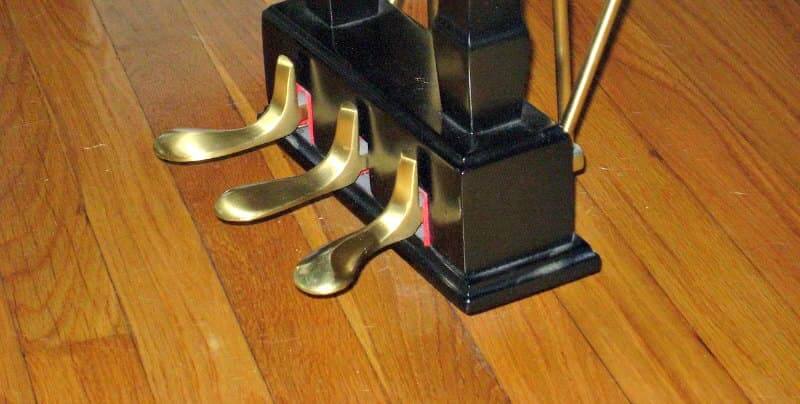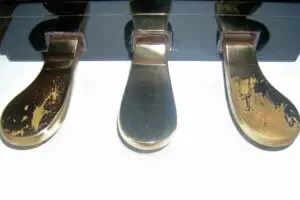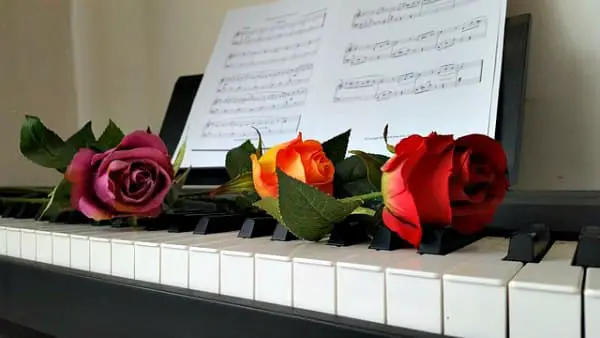- Home
- Piano Technique
- Piano Pedals
How to Use the Piano Pedals
The piano pedals demystified!
Learn about the pedals of the piano and how to play the piano using easy pedaling techniques.
This article may contain compensated links. Please read the disclosure for more info.
The pedals of the piano are tools for changing the sound or color of the piano tone.
Piano pedals can create wonders when appropriately used but could also "destroy" a piece if used without knowledge or care.
Remember that the most significant "controller" when using the pedals is your ears. Whatever the instructions say in the score, if it sounds terrible, change it!
The piano pedals can look different and have different functions on different pianos. Some pianos have two pedals, some three.
So what are they used for, and what are they called?
The Functions of the Piano Pedals
4 Types of Piano Pedals

There are actually four types of piano pedals. But there is only a max of three on a piano.
Three have basic "expressive" functions, but sometimes one of them has an "alternative" function of muting the piano (to not disturb the neighbors).
1. "Sustain" or "Damper" Pedal
The most used pedal is the Sustain or Damper pedal to the right. Sustain means to hold or keep something.
In this case, as you press the Damper pedal, sound from all strings in the piano gets "freed" as the damper is raised off the strings, and the notes played blend for a rich sound.
You will control the Sustain/Damper pedal with your right foot. After learning how to use it properly, you will probably use it in almost every piece you play!
 Left: The Una Corda Pedal. Middle: The Sostenuto Pedal. Right: The Sustain or Damper Pedal.
Left: The Una Corda Pedal. Middle: The Sostenuto Pedal. Right: The Sustain or Damper Pedal.2. The "Sostenuto" Pedal
There is sometimes a pedal in the middle, which on a grand piano is called the Sostenuto pedal. This pedal is also controlled with your right foot.
Actually, the word Sostenuto means sustained, but in this case, the function "locks" only specific keys to get a "damp" effect. For example, you want a chord being held while playing staccato or short notes without blending them somewhere else.
This is a fun effect but very rarely used. Some grand pianos do not have this pedal but have only the Damper and the Una Corda pedals.
You may find a Sostenuto pedal on some upright pianos, like the Yamaha U3. (But not to be confused with the third pedal on many upright pianos, which I call the "extra" function, see below.)
3. The "Una Corda" Pedal
To the left is the Una Corda pedal. Again Italian, meaning "one-string."
You can see how the mechanism moves the whole keyboard to the right on a grand piano. In doing so, the hammers that usually hit up to three strings hit one less.
On an upright piano, the hammers inside get moved a bit closer to the strings, which slows the speed of the hammer and, in this way, makes it possible to get a similar effect.
The Una Corda pedal gives a "sordine" or muted effect and makes it easier to play softer with a subtle change in tonal color. This pedal you will control with your left foot.
4. "Extra" function
There is another function of the middle pedal in many upright pianos.
When pushed down and locked to the side, the middle pedal allows a layer of felt cloth to be lowered in front of the strings. This makes the sound very much muted.
I call it the "neighbor pedal"; it is to be used when you want to avoid being too loud and disturbing. However, the sound is terrible, and I would suggest using this only when absolutely necessary. (I find it better to cover the piano with a thick blanket instead!)
How to Use the Piano Pedals
The first piano pedal you'll use is the Damper pedal to the right. Playing the piano and using the piano pedals can be tricky the first time.
But there are tricks to learning it. In the beginning, we use two main techniques when using the damper pedal:
- The "syncopated" pedal technique, which is the most common, is used to create a rich legato sound.
- And the "rhythmic" pedal technique can both be used to emphasize the rhythm of a piece, and where otherwise shorter note values should be played, just to bring out some "color."
Piano Pedaling Exercises
For the following exercises, you will only use your sustain or damper pedal to the right with your right foot.
Tip: Check out: Piano Pedaling Lessons and Repertoire for beginners' tips and exercises in the pedaling technique.
- First: Make sure to sit with the correct posture. Sit on half the piano bench with both feet on the floor next to the piano pedals. Keep an approximate 20-30 cm distance from your torso to the keyboard; do not sit too close!
- Next: Put your right foot on the sustain pedal to the right. Put only the front part of your foot so that your heel can stay comfortably on the floor at all times. Remember to always keep your heels on the floor!
1. Syncopated Pedal Technique
- Start by counting 1-2-3-4 repeatedly in a steady rhythm.
- On every 2, press down the pedal and hold until 1, where you lift it. Make sure to make a smooth lift and not let it make a noise!
- So it will be UP-DOWN-HOLD-HOLD again and again.
- Repeat this as many times as needed to make it smooth and natural.
- Next, play a note on every "1" and hold it while keeping the pattern going with your foot on the pedal.
- You can change notes or just play the same over and over.
Your pattern will look like this, (with the note C):
(U = Up, D = Down, - = Hold)
Count: 1 2 3 4 1 2 3 4
Play : C - - - C - - -
Pedal: UD - - UD - -
Keep repeating until fluent.
Now: Faster changes!
Count: 1 & 2 & 3 & 4 &
Play : C - - - - - - -
Pedal: UD - - - - - -
This is the "essence" of the Syncopated pedal!
2. Rhythmic Pedal Technique
When using the syncopated pedal, you did the "opposite" of your playing; your foot went up when you played a note.
When playing rhythmic pedal, you will do the "same" as your playing; when you play a note, you will also press down the pedal! This is a bit easier.
Count: 1 2 3 4 1 2 3 4
Play: C - - - C - - -
Pedal: D - - U D - - U
This will leave a "gap" between the groups of 4 and not let the notes overlap as in the Syncopated pedal technique above.
Of course, the amount of counts you keep the pedal down depends on the length of the note value or the effect you want to achieve. In a waltz, for example, you might want to play:
Count: 1 2 3 1 2 3
Play: C E E C E E
Pedal: D U - D U -
Piano Lesson on The Basics of Pedalling
How the Piano Pedal is Written
The pedaling is sometimes written in the score, sometimes not.
The way to write it has changed over time and has not been written too exact in the past. It is probably because the pianist has always been expected to add the pedal in good taste.
And this is important! Piano's differ, the acoustic in different rooms differ.
You always have to use your ears to hear if the pedal is good and serves the interpretation of the piece or not, no matter how well written the instructions are in the score.
A commonly used pedal sign:

It is easy to follow and rather exact. You follow the line with your foot, so to speak: Down, Hold, Up-Down, Hold, Up.
In older sheet music, you will often see this sign. It means (Ped.) press the pedal down:

And this means to let the pedal up:






